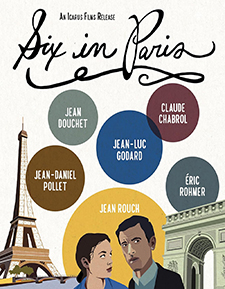Six in Paris (Blu-ray Review)

Director
Claude Chabrol, Jean Douchet, Jean-Luc Goddard, Jean-Daniel Pollet, Éric Rohmer, Jean RouchRelease Date(s)
1965 (July 30, 2024)Studio(s)
Les Films du Cyprès/Les Films du Losange (Icarus Films/Vinegar Syndrome)- Film/Program Grade: A-
- Video Grade: A
- Audio Grade: A
- Extras Grade: B-
Review
An anthology film of little comedy-drama vignettes, Six in Paris (onscreen title: Paris vu par… Claude Chabrol, Jean Douchet, Jean-Luc Goddard, Jean-Daniel Pollet, Éric Rohmer, and Jean Rouch, or Paris Seen By... 1965) was produced by Barbet Schroeder, later a prominent director himself, in 16mm with two-reel-long segments (15-20 minutes apiece) from prominent and lesser-known members of the French New Wave. The project seems to have been something of a lark, as if a bunch of friends had gotten together and threw something together over several weekends. The results are consistently agreeable with no one segment standing out. Pleasant trifles, these.
The first segment, Saint-Germain-des-Prés, directed by Jean Douchet, is an amusing short about an adventurous American student, Katherine (Barbara Wilkin), who picks up a handsome young man, Jean (Jean-François Chappey) at a café, they drive to his apartment in his handsome Bentley, and have passionate sex. The next morning, he’s in a big hurry to abandon her, claiming he has to catch a flight for Mexico to meet his diplomat father, and she’s hurt by his callousness. Soon after, she encounters another handsome young man under suspiciously similar circumstances.
In Gare du Nord, directed by Jean Rouch, easy-going and contented Jean-Pierre (played by producer Schroeder) and girlfriend Odile (Nadine Ballot) are eating breakfast, he listening to her constant nagging. Finally, she’s had enough and storms out, where she encounters a man (Gilles Quéant) who appears to be everything Jean-Pierre is not. This segment is notable in that virtually the entire segment (about 15 minutes long) is done in a single, uninterrupted take.
In Rue-Saint-Denis, directed by Jean-Daniel Pollet, lowly dishwasher Léon (Claude Melki) hires a worldly prostitute (Micheline Dax), he obviously a nervous first-timer. To put him at ease, they first eat dinner in his apartment and, in a funny scene, she reclines on his bed and reads the newspaper.
In Place de I’Étoile, directed by Éric Rohmer, Jean-Marc (Jean-Michel Rouzière) works at a men’s clothing shop just off the Ace de Triomphe. After an encounter with a rude stranger (Marcel Gallon), Jean-Marc knocks him to the ground, apparently killing him. To avoid suspicion, he takes a different route to and from work, the area around the Arc famously confusing.
In Montparnasse-Levallois, directed by Jean-Luc Godard and photographed by American documentarian Albert Maysles, Monica (Joanna Shimkus, later the wife and widow of Sidney Poitier) accidentally mixes up two letters she mails to her two lovers, Ivan (Serge Davri) and Roger (Philippe Hiquilly). The plot is derived from Godard’s earlier film A Woman Is a Woman (1961), when Jean-Paul Belmondo reads a news story about the incident to Anna Karina.
In the final segment, La Muette, directed by Claude Chabrol, Chabrol himself along with then-wife Stephanie Audran play the parents of a young boy (Gilies Chusseau) who, tired of listening to his parents’ constant bickering, starts using earplugs to deaden their noise, with grimly humorous results.
I suppose I liked the Douchet, Rouch, and Rohmer segments best, but unlike other anthology films with distinct highs and lows, these are all pretty good. There’s nothing linking the segments beyond the Paris setting, most of them offering little touristy views of various parts of the city, though much of the film’s running time is spent in cramped Parisian apartments too small to swing a cat in.
The single, hand-held take in the Rouch segment is technically impressive—at one point, actress Ballot subtly moves her hands as if signaling a crew member or passerby to get out of her way as she’s strolling down a sidewalk—but each segment looks like it was shot quickly, in a day or three at most. Though modest in its aims, Six in Paris is reasonably engrossing.
Shot in 16mm (color, for 1.33:1 projection), the restored-in-2K image looks very good even projected onto a large home theater screen. (An introductory shot and perhaps some credits and other linking material may have been filmed in 35mm.) The French 2.0 mono DTS-HD Master Audio, supported by English subtitles, is better than adequate, and the disc is Region “A” encoded.
Extras are limited to three short black-and-white interviews from 1965, each running about five minutes, with Schroeder, Rouch, and Rohmer that originally aired on Swiss television.
For fans of Godard, Chabrol, and/or Rohmer, as well as the less-familiar lights of the other three filmmakers, Six in Paris is an interesting, offbeat release. Recommended.
- Stuart Galbraith IV

